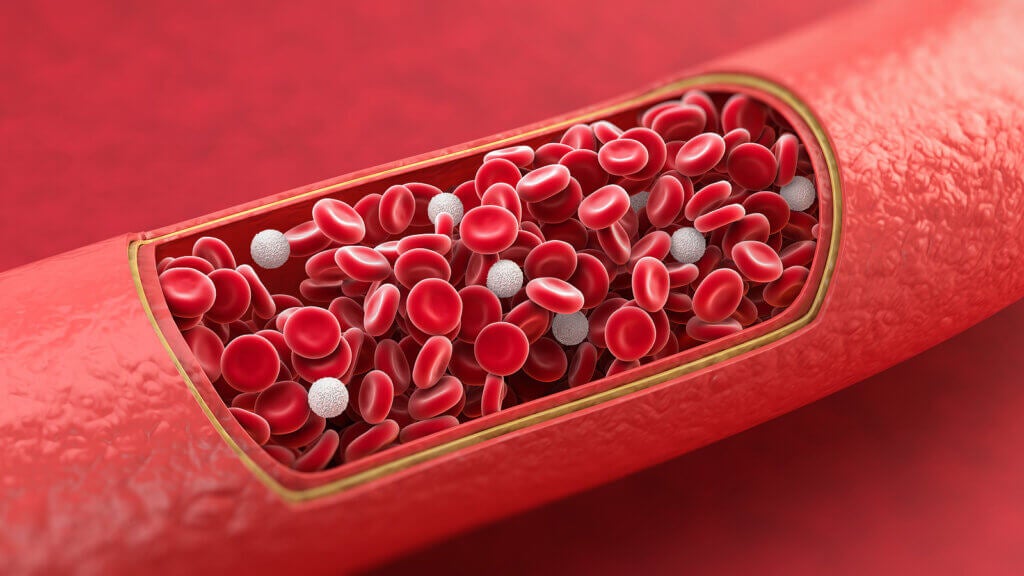Migraines During Breastfeeding: What You Should Know

During pregnancy, some women can often suffer from migraines. However, as the third trimester approaches, these tend to become increasingly mild, because estrogen levels reach a certain stability. However, these can return later during breastfeeding. Migraines during breastfeeding can be quite common. This is because after delivery the hormone levels change drastically again.
Let’s bear in mind that every time a woman goes through a series of changes related to the reproductive system, the risk of experiencing discomfort increases. For the most part, these don’t usually pose a serious health problem, but they can certainly be unpleasant.
Generally speaking, migraine headaches and other complaints can be interpreted as a sign that the body is adapting to changes. Let’s have a closer look.
Migraines during breast feeding and postpartum
After giving birth, women can get migraines, whether they’ve had them before (before or during pregnancy) or not. The reason is unknown, but expert suspect that hormonal activity is an important component.
In most studies on migraines during breastfeeding, experts have observed that the intensity of pain tends to be greater, especially during the first week of the postpartum period. So, if the migraines were moderate in intensity in pregnancy, they can often be severe in the postpartum period.
It’s important to clarify that breastfeeding isn’t the reason why migraines occur, and so you shouldn’t stop doing it. On the contrary, the practice helps to regulate estrogens and progressively reduce pain.
Women of reproductive age (20-45 years) are more likely to suffer from migraines at different stages of their life, including breastfeeding.

Using migraine medications while breastfeeding
For most women, these pains improve or stop around the third month of pregnancy. However, if they don’t, it’s possible to treat them.
Home methods (relaxation exercises, deep breathing, cold compresses, rest, hydration) and medications authorized by the doctor are recommended for the treatment of migraines during lactation. You should realize that certain drugs can cross the placenta and also reach breast milk. Because of this, it isn’t advisable to resort to self-medication or home remedies without the authorization of your doctor.
First-line drugs
According to a study published in the journal Neurology, which includes the Recommendations of the Headache Study Group of the Spanish Neurology Society (GECSEN), the symptomatic treatment of migraines during lactation may include some simple analgesic medications.
Paracetamol is considered the safest medication in pregnancy, as well as in lactation. That’s why your doctor may authorize it at certain times.
Always keep in mind that, when it comes to migraines, even if the medications are aimed at providing relief, taking them in excess can have the opposite effect and aggravate the problem. Each person reacts in a different way, which is why it’s so important to always follow professional advice.
Other first-line drugs are beta-blockers, specifically, propranolol and metoprolol.
Second-line drugs
Taking into account the aforementioned study, we know that the second-line treatment of migraines during lactation is the use of non-steroidal anti-inflammatory drugs (NSAIDs). Ibuprofen is considered the safest, while the rest of the NSAIDs should be used with greater caution.
Other drugs that may be included in the treatment of migraines are lamotrigine (which also helps prevent migraines with aura) and amitriptyline. However, in the case of the latter one must be vigilant to see if it causes if it causes drowsiness or anticholinergic effects in your newborn baby.
Other options
Chlorpromazine and intravenous metoclopramide are safe options for treating migraines while breastfeeding. Parenteral diclofenac or subcutaneous sumatriptan could also be administered.
Contraindicated drugs
As with other types of migraine, opioids are not recommended in the treatment of migraine during breastfeeding. Among other things, it’s because they aggravate gastric motility and nausea.
Other contraindicated substances are the following:
- Atenolol
- Lithium
- Flunarizine
- Pregabalin
- Venlafaxine

When to go for a consultation if I have a migraines during breastfeeding?
Whether you have a family history of migraines or not, it’s important that you notify your doctor if you experience migraines so that they can guide you on the most appropriate treatment. Additionally, remember that it’s essential that you rely on self-care as prevention and relief measures.
Migraines have no cure, but they can be controlled with appropriate methods. Of course, good habits during breastfeeding will always help you and your baby and make things more comfortable for you both.
During pregnancy, some women can often suffer from migraines. However, as the third trimester approaches, these tend to become increasingly mild, because estrogen levels reach a certain stability. However, these can return later during breastfeeding. Migraines during breastfeeding can be quite common. This is because after delivery the hormone levels change drastically again.
Let’s bear in mind that every time a woman goes through a series of changes related to the reproductive system, the risk of experiencing discomfort increases. For the most part, these don’t usually pose a serious health problem, but they can certainly be unpleasant.
Generally speaking, migraine headaches and other complaints can be interpreted as a sign that the body is adapting to changes. Let’s have a closer look.
Migraines during breast feeding and postpartum
After giving birth, women can get migraines, whether they’ve had them before (before or during pregnancy) or not. The reason is unknown, but expert suspect that hormonal activity is an important component.
In most studies on migraines during breastfeeding, experts have observed that the intensity of pain tends to be greater, especially during the first week of the postpartum period. So, if the migraines were moderate in intensity in pregnancy, they can often be severe in the postpartum period.
It’s important to clarify that breastfeeding isn’t the reason why migraines occur, and so you shouldn’t stop doing it. On the contrary, the practice helps to regulate estrogens and progressively reduce pain.
Women of reproductive age (20-45 years) are more likely to suffer from migraines at different stages of their life, including breastfeeding.

Using migraine medications while breastfeeding
For most women, these pains improve or stop around the third month of pregnancy. However, if they don’t, it’s possible to treat them.
Home methods (relaxation exercises, deep breathing, cold compresses, rest, hydration) and medications authorized by the doctor are recommended for the treatment of migraines during lactation. You should realize that certain drugs can cross the placenta and also reach breast milk. Because of this, it isn’t advisable to resort to self-medication or home remedies without the authorization of your doctor.
First-line drugs
According to a study published in the journal Neurology, which includes the Recommendations of the Headache Study Group of the Spanish Neurology Society (GECSEN), the symptomatic treatment of migraines during lactation may include some simple analgesic medications.
Paracetamol is considered the safest medication in pregnancy, as well as in lactation. That’s why your doctor may authorize it at certain times.
Always keep in mind that, when it comes to migraines, even if the medications are aimed at providing relief, taking them in excess can have the opposite effect and aggravate the problem. Each person reacts in a different way, which is why it’s so important to always follow professional advice.
Other first-line drugs are beta-blockers, specifically, propranolol and metoprolol.
Second-line drugs
Taking into account the aforementioned study, we know that the second-line treatment of migraines during lactation is the use of non-steroidal anti-inflammatory drugs (NSAIDs). Ibuprofen is considered the safest, while the rest of the NSAIDs should be used with greater caution.
Other drugs that may be included in the treatment of migraines are lamotrigine (which also helps prevent migraines with aura) and amitriptyline. However, in the case of the latter one must be vigilant to see if it causes if it causes drowsiness or anticholinergic effects in your newborn baby.
Other options
Chlorpromazine and intravenous metoclopramide are safe options for treating migraines while breastfeeding. Parenteral diclofenac or subcutaneous sumatriptan could also be administered.
Contraindicated drugs
As with other types of migraine, opioids are not recommended in the treatment of migraine during breastfeeding. Among other things, it’s because they aggravate gastric motility and nausea.
Other contraindicated substances are the following:
- Atenolol
- Lithium
- Flunarizine
- Pregabalin
- Venlafaxine

When to go for a consultation if I have a migraines during breastfeeding?
Whether you have a family history of migraines or not, it’s important that you notify your doctor if you experience migraines so that they can guide you on the most appropriate treatment. Additionally, remember that it’s essential that you rely on self-care as prevention and relief measures.
Migraines have no cure, but they can be controlled with appropriate methods. Of course, good habits during breastfeeding will always help you and your baby and make things more comfortable for you both.
- Cefalea: embarazo y lactancia. Recomendaciones del Grupo de Estudio de Cefaleas de la Sociedad Española de Neurología (GECSEN) [Internet]. Neurología. 2019 [cited 2021 Jun 27]. Available from: https://www.elsevier.es/es-revista-neurologia-295-articulo-cefalea-embarazo-lactancia-recomendaciones-del-S021348531930009X
- Doblas Gómez PA, Martín Orlando J, López Díaz AC. Migraña y gestación. Revisión bibliográfica [Internet]. Vol. 42, Clinica e Investigacion en Ginecologia y Obstetricia. Elsevier Doyma; 2015 [cited 2021 Jun 26]. p. 72–4. Available from: https://www.elsevier.es/es-revista-clinica-e-investigacion-ginecologia-obstetricia-7-articulo-migrana-gestacion-revision-bibliografica-S0210573X14000227
- Migraña | Oficina para la Salud de la Mujer [Internet]. [cited 2021 Jun 25]. Available from: https://espanol.womenshealth.gov/a-z-topics/migraine
- Sequeira Quesada CM. Abordaje terapéutico de la migraña en la mujer embarazada y en lactancia. Rev Clínica la Esc Med UCR-HSJD [Internet]. 2019 [cited 2021 Jun 27];9(6):21–30. Available from: https://www.medigraphic.com/pdfs/revcliescmed/ucr-2019/ucr196c.pdf
- Silberstein SD. Migraña – Trastornos neurológicos [Internet]. Manual MSD versión para profesionales. [cited 2021 Jun 25]. Available from: https://www.msdmanuals.com/es/professional/trastornos-neurológicos/cefalea/migraña
Este texto se ofrece únicamente con propósitos informativos y no reemplaza la consulta con un profesional. Ante dudas, consulta a tu especialista.







